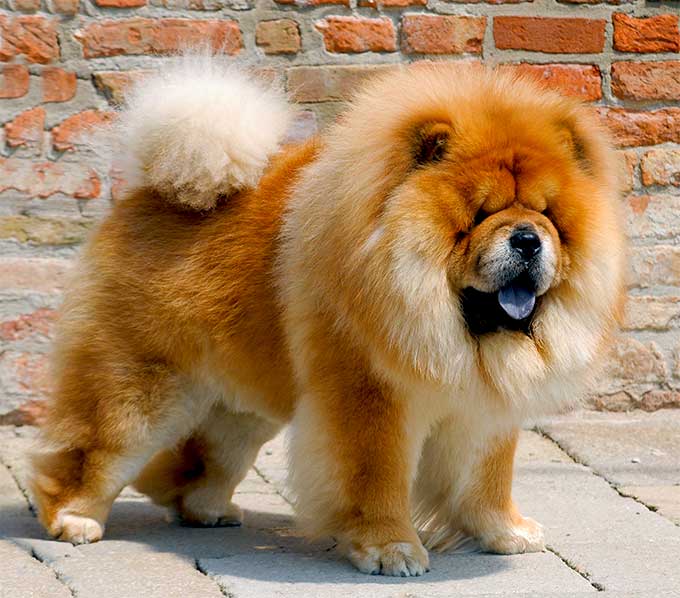- Chow Chows are predisposed to: gastric dilation volvulus, diabetes, glaucoma, entropion, ectropion, hip dysplasia, ruptured cranial cruciate ligament, elbow dysplasia, hyperthyroidism, renal dysplasia, and melanoma.
- Chow Chows are sometimes bought without any clear understanding of what goes into owning one, and these dogs often end up in the care of rescue groups, in need of adoption or fostering.
- Chow Chows are prone to quite a number of health and behavioural disorders, and as with any breed, it is advisable to always source a puppy from a reputable breeder.
- Chow Chows are fiercely intelligent but are impatient, and will not take kindly to being teased or even young children accidentally playing roughly with them.
- Chow chows are resistant to obedience training but do need to be taught to walk well on a lead and should have plenty of early and ongoing socialisation.
- Chow chows are fairly intelligent but they have both an independent and a stubborn streak, so training them can be a challenge.
- Chow Chows are easily adaptable dogs that will thrive in various environments, from small apartments to lavish palaces.
- Chow Chows are prone to a common condition called hypothyroidism in which the body doesn’t make enough thyroid hormone.
- Chow Chows are not quite as gruff as their scowls imply, but are independent of spirit and standoffish with strangers.
- Chow Chows are often mixed with other breeds who can water down some of this breed’s dominant characteristics.
Contents
Life expectancy
Other common questions people have about this breed include, “How long do Chow Chows live?” and “Are Chow Chows hypoallergenic?” First, on average, a Chow’s life expectancy is between 8-12 years, although many are known to live to the age of 15. And unfortunately, Chows are not hypoallergenic dogs. Between their bear-like coats and their tendency to shed all year round, individuals who are allergic to dogs should definitely consider a different breed.
Training
Given their rather unique personality traits, training a Chow can be a different challenge to training most breeds. They respond best to training from one individual, as they usually bond most strongly to one person, to whom they will respond best when corrected or given an instruction. Verbal reward and reprimand usually works well, but persistence is required to overcome the Chow’s natural stubbornness. The key to successful training of a Chow Chow is early establishment of a healthy dominance by humans, as any dog which does not have this level of respect for the owner’s authority from puppyhood is likely to become a very difficult animal to train in later life.
Barking
Chow chows are not usually social, outgoing dogs. They tend to be aloof with strangers and can be aggressive with other dogs. This is fitting with their history as guard dogs for homes and livestock. Early socialization to other dogs, pets and people is important. Chow chows may become nuisance barkers if their alarm barking is not controlled.
Breed
They are good with the kids and other pets of the household. Find Chow Chow|Labrador Retriever Dog Breed in Ahmeek Village. This is to keep wax and moisture under control. They will do well with an active family who enjoys long walks and afternoons in the sun.
Social
A Chow Chow must be extensively socialized — introduced to new people, dogs, and situations — as a puppy if he’s going to be safe and relaxed as an adult.
Energy
Most chow chows are medium to low energy dogs, preferring to lounge around, rather than romping in the woods. However, many enjoy some playtime with squeaky toys or tug of war. Their thick coat means they must be careful not to become overheated in the summer. That said, several trainers have been successful with these dogs in competitive agility and obedience.
Health
Like any dog, an adult Chow Chow needs daily exercise to stay healthy and happy, but not much — he’ll be satisfied with a couple of 15-minute walks daily or one longer walk.
Coat
The Chow Chow and Corgi mix, or the Chorgi, is a beautiful dog. They manage to retain the facets of the Chow Chow that they are prized for — a thick, long coat and a blue-black tongue — combined with a shorter body, for a smaller version of a Chow Chow.
Temperament
Temperament Most commonly kept as pets, Chow Chows tend to display discernment of strangers and can become fiercely protective of their owners and property. The American Kennel Club standards, however, consider an all-too aggressive or all-too timid Chow Chow to be unacceptable. For that reason, some owners have attributed a cat-like personality to the Chow Chow.
History of Chow Chows
- In 1781, the Chow was described in a British book, Natural History and Antiquities of Selbourne, by naturalist Gilbert White.
- In the 1820s Chow Chows were exhibited at the London Zoo as the “Wild Dogs of China,” but they didn’t really catch on in the West until Queen Victoria, an inveterate dog lover, acquired one later in the century.
- In 1931, the government of Japan declared the Akita breed to be a national monument and one of Japan’s national treasures.
- In 1937, on a visit to the Perfecture of Akita , she commented on how much she admired the breed and would like to have one of her own.
- In 2016, after winning best in breed at Crufts, a very slope backed GSD ignited public outrage.

